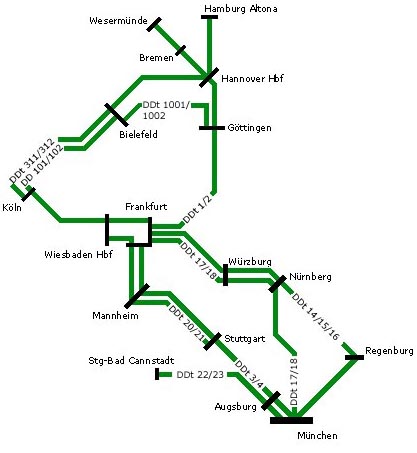Epoch III
Introduction
A new start
The first trains after the war
The first network of long-distance trains
Moving forward, more trains, more comfort, more regularity
Pre war rolling stock again in service
The start of an international long-distance network
The blue network of fast express trains
The modern era, the rise of electric locomotives
The modern diesel locomotive is coming
A new class of coaches
The third class is abandoned
The last new steam engine
A new prestious network, the Trans Europ Express
The Rheingold, from 1962 again exclusive
A new star on rails, the electric locomotive E 03
The first network of long-distance trains
Besides the few D and E-trains for the long-distances which were exploited by the different railway companies in the four zones, the American and Britsh forces decided to start up a new network of express trains. This so-called "Dienst-D-Züge" network was exclusively meant for the American and Britsh officials and military. The network was coordinated and exploited by the allied forces.
This new network was set up as a sort of "service" network, because the different administrations were settled in different cities, and because the few existing long-distance service were very poor. The network also served for the just starting trade. The new connections which connected cities in the two different zones was only accesible for allied officials and a small group of prejudiced people.
The trains connected mostly cities located in the American and Britsh zones, the so-called "Bizone". In the French zone all trains were exploited by the railway company in the French zone.
These first high graded (as far as you could speak of high graded) long-distance services could hardly compared with the good pre war long-distance services of the DRG. Many rolling stock was spreak out over Europe during the war and a large part was destroyed. But most of the SVT trainsets were in an avarage condition, althought many were transformed and rebuilt into exclusive trainsets for nazi officers. These trainsets and a portion of the coaches which were in avarage condition, were confiscated by the allied forces to serve in their network.
So already a year after the ending of the war in Germany there was a network of Dienst-D-Züge for a small group of people which connected the important cities and which offered for that time reasonably services.
On 17 July 1946 the following 8 trains were in service in the Dienst-D-Züge network, here you can see the network schematically:
 | | DDt network 1946 |
- DDt 1/2 Frankfurt/M - Weselmünde
- DDt 3/4 München Hbf - Frankfurt/M Hbf
- DDt 14/16/15 Frankfurt/M Hbf - München Hbf
- DDt 18/17 Frankfurt/M Hbf - München Hbf
- DDt 20/21 Wiesbaden Hbf - Stuttgart Hbf
- DDt 22/23 München Hbf - Stutgart Hbf
- DDt 1001/1002 Bielefeld Hbf - Göttingen Pbf
- DDt 311/312 Hamburg Altona - Köln-Deutz
- DD 101/102 Frankfurt/M Hbf - Düsseldorf Hbf
The DDt trains were SVT trainsets (mainly of type Hamburg and Köln), and the DD trains were pulled trains with a locomotive and coaches. Sometimes the DDt trains were also indicated as Dsts trains.
As a result of this jointly network the military governors of the American and Britsh zones signed on 10 September 1946 an agreement to setup a new corporate administration for the Bizone. As a result of this, on 1 Oktober 1946 the "Hauptverwaltung der Deutschen Reichsbahn in der Bizone" was founded in Bielefeld.
As a reaction on the difficulties which the nation struggled in the very hard winter of 1946/47, the US and UK decided to join their zones administratively and economically together from 1 January 1947. The new formed territory was officially called the "Bizone". Another reason for this decision was also the fear for the expansion of the communism. France and the Sovjet Union protested against the forming of the Bizone. The administrations for post, traffic, economy, finance, labour and agriculture were joined together. The head office of the Bizone was settled in Frankfurt am Main. The intention to make Germany again one nation bounced on resistance from France. Especially the Americans wanted that Germany was quickly economically independent.
From the spring of 1947 the allied forces were forced to put also special "Dienst-coaches" in service in some domestic and international trains. These coaches were not accesible for "normal" travelers but only for allied officials. The coaches were second class coaches. Between Frankfurt, Bielefeld and Bremerhaven, Frankfurt and München as well as between Würzburg and Hamburg were also sleeping coaches in service. This was done because of the long travel times as a result of the poor infrastructure. And hotel accomodations were very scarces. These train services were also partly found in the regular timetables. At the end 1947 the DD trains disappeared and were converted to D-trains, they were now accessible for all travelers. Now only a couple of DDt trains were in service in this network. And with the new timetable on 2 October 1949 also the DDt trains disappeared from the timetables.
|
